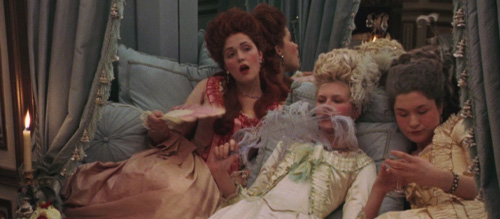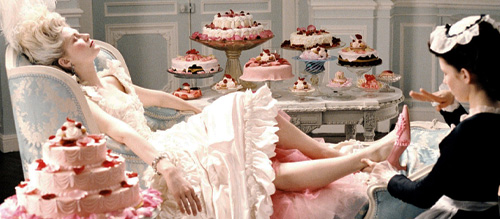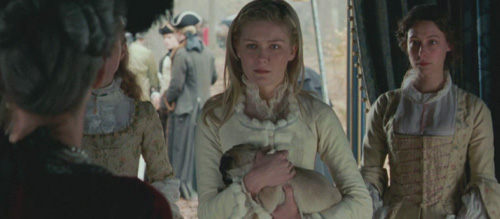Marie Antoinette and the Art of Historical Inaccuracy
There are two versions of Marie Antoinette that are equally important and historically relevant. The first is the Austrian-born monarch who was put to death during the French revolution and is known for her catchphrase “let them eat cake!”. The second is a pink-haired teenager played by Kirsten Dunst who listens to The Strokes in her castle and loves sweets. She ruminates on the loneliness of young adulthood and distinctly never told anybody to eat cake.
While Queen Marie gets her head chopped by an angry French mob, Marie Antoinette is beheaded by critics. Though the reviews are mixed, almost everyone agrees that the film is a vapid mistelling of a historical event that prefers style over substance. Pete Hammond of Maxim Magazine insists that the film is too concerned with being “contemporary” and “pink”. Toronto Star critic Susan Walker proclaims that director/writer Sofia Coppola “squanders a once-in-a-lifetime chance to film on the grounds…of Versailles” (via Rotten Tomatoes). At best, the film is a fashion show, at worst, it is another trip to the guillotine.
Perhaps the film does offer an approach that is more style than substance, but that’s the point. Marie Antoinette serves more as an impressionist painting of the historical figure. Sure, the form is the same, but Coppola’s beautifully messy portrait is far more compelling to a modern audience. Though representing different moments in time, Coppola’s film has inspired a generation of female filmmakers to center on the inner lives of female protagonists. Works like Persuasion and even Lady Bird draw on Coppola’s distinct style and her attention to fashion. Coppola leads with empathy, beauty, and style instead of the usual academia presented to us in period pieces. At the time, this decision was highly questionable, but Coppola’s eye for style and her dedication to constructing a compassionate retelling of Marie Antoinette’s story has transformed the film into a cult classic.

Immediately, Coppola asserts that the film will not be a by-the-books biopic of the French Monarch. In the opening, “Hong Kong Garden” blares loudly as Marie gazes blankly into the distance. She’s certainly dressed the part – adorned in a fluffy white dress – but her position is unorthodox for a woman of royal stature. She has got her feet kicked up on an ottoman and her finger is knuckle deep in an enticing pink cake. Already, the shot poses a paradox. Marie is styled like a 16th-century It girl, but the discordant pose, music, and facial expressions counter our expectations. We wrestle with this tension throughout the film, and it mirrors Marie’s struggle to fit into the royal lifestyle forced upon her.
In the final moments of the shot, Marie glares directly into the camera, dead-eyed. This brief fourth wall break communicates a sense of self-awareness, both from the filmmaker and Marie herself. Coppola nods to the audience as if to say “I know” about the historical inaccuracies. Marie communicates a more solemn loneliness. She is disconnected from the world she lives in. Half teenager, half sheltered queen-to-be.

Since her iconic Virgin Suicides debut, Coppola has explored the theme of existential loneliness. Fashionable women meandering through life, barely tethered to their earthly circumstances. Though they may have material goods, her characters lack autonomy and an internal sense of purpose. Marie Antoinette explains that this feeling is not an epidemic of female hysteria, but a historically enduring part of the female condition. We don’t get a minute-by-minute recap of Marie’s life, but rather a sympathetic nod from present women to past ones. Coppola dares to inspect the female interior, pulling from modernist traditions of examining domestic life. By reframing Marie’s story on her most intimate moments, the film aptly exposes the struggle for control women have always faced.
We see this gesture when Marie first arrives in France in a wonderful blur of fact and fiction. On the day she is set to become the heir to the French throne, Marie arrives by carriage with pin-straight hair, carrying her pug Mops under one arm. She is the picture of a regular 2006 teenager adorned with royal trappings. One very true fact about the ordeal is Marie’s young age. Scarcely 14, Marie is stripped naked in the forest and the dog is ripped from her arms.

While watching this scene, Marie reads more like the new girl in high school than future royalty. Coppola riffs on classic 2000s It girl trends like the straight blonde hair and the girly girl with the tiny dog. It makes it all the more painful to witness Marie be dressed down and robbed of her creature comforts. This historical subversion is like watching the prom queen have her dress torn off in the middle of crowning.
This blend of history and fantasy is entirely purposeful. Rather than portraying the stuffy historical figure who was perhaps rightfully executed, Coppola centers her story on a lost teenage girl partying and struggling her way through adolescence. At the time, this was seen as a foolish endeavor, but after years of past, we read the film in an entirely new light.
After the hate campaign and eventual apologies to female celebrities like Britney Spears and Anne Hathaway, society has come to a place of reckoning with women and their stories. As the pendulum swings, audience members and critics are beginning to realize that women are not vessels for their hatred and disdain. Maybe these harrowing tales of trials and tribulations are not silly, they just come from a different perspective.
Coppola, in this way, was ahead of the curve. She took a controversial (if not downright hated) figure and forced the audience to feel empathy for her. In a time when the teenage girl was synonymous with fashion, fun, and rebellion, Coppola blended these elements with historical styling to tell the story of all misunderstood young women. Detached, moody, and strangely dressed, Marie Antoinette works as a stand-in for modern teenage scapegoats..
In 2022, we see Coppola’s revelatory filmmaking hard at work. Though history hasn’t been completely forgotten, many marginalized filmmakers prefer a healthy blend of reality and fantasy. Shonda Rhimes famously employed colorblind casting in her Regency-era romance, ‘Bridgerton’. While the film Persuasion employed fourth wall breaking and other modern storytelling devices in a retelling of the Jane Austen novel. Like Coppola, they embrace the glamour and style of the time but shed the less desirable qualities of the period. Marie Antoinette – which, by this time is labeled a cult classic – paved the way for films to make 21st-century points using historical backdrops. Storytelling through film has become richer and more complex due to this shift away from literal interpretations. We can understand social dynamics through the lens of our past and make connections to those who come before us. As we look to the future, we can expect a beautiful tapestry of the future, past, and present woven together to tell meaningful stories. Coppola’s vision, drive, and proclivity for style pushed this movement forward in a way that will forever alter the film world.
Written by Emi Grant
You can support Emi Grant in the following places:
Instagram – @emi.grant
Portfolio – grantemi.portfolio.com
Twitter – @emii_grant

